
About The Four C’s

About the Color
Studdedbay has diamonds with grades D to K, where D represents ‘colorless’ and K represents ‘slightly or faintly colored.’ Studdedbay doesn’t sell diamonds of grades L to Z because they have a noticeable yellow tint that doesn’t meet the quality standards at Studdedbay.
D-F Color Diamonds: These diamonds are of the highest quality, extremely rare, and have a pure ice look with high precision, with no color.
G-H Color Diamonds: look almost colorless, with no warm hues of color, and are a great pick within your budget.
I-J Color Diamonds: Just like G-H, these have almost no color and are a great pick within your budget.
K Color Diamonds: are faintly colored and go well with yellow gold. They are also budget-friendly.
About the Cut
Excellent: The diamonds in this particular category have the best sparkle. As light enters the diamond, it is reflected internally from different mirror-like facets and dispersed evenly. This balances the white light and flashes of fire, providing the diamond its shine.
Very Good:The Cut might not be perfect, but the light entering almost gets reflected through the crown. It is priced lower than the excellent Cut and represents the top 15% of the cut quality of a diamond.
Good: Diamonds in this grade reflect most of the light that enters, but not as Excellent and Very Good grade. They appear darker with a lack of contrast.
Fair: These diamonds are slightly dull and don't have perfect cuts which result in light leakage. Diamonds with poorly cut pavilion facets are prone to light leakage, resulting in dull, lifeless diamonds.


About the Clarity
I1, I2, I3: these have noticeable inclusions, they impact the diamond looks. Studdedbay does not sell I1 diamonds for engagement rings.
SI1, SI2 (Slightly Included): minor inclusions visible under 10X magnification. 3. VS1, VS2 (Very Slightly Included): has minor inclusions when seen under 10X
VVS1 VVS2 (Very, Very Slightly Included): these contain tiny inclusions, even the trained eyes fail to see flaws under 10X magnification.
There are a lot of factors that affect Diamond Clarity. Let’s dive deep into these factors:
1. Inclusions or characteristics can turn into reflectors depending on their Position, which further impacts the clarity grade.
2. The number of characteristics that can be easily spotted. Fewer characteristics imply a higher clarity grade.
3. The Nature of characteristics defines the type of inclusion and its impact on the toughness of the diamond.
4. Color and relief play an essential role in the visibility of a characteristic.
Tips on Diamond Clarity
When it comes to the Clarity of the diamond, there are a lot of misconceptions and wrong beliefs. The first one being that the highest clarity grade ensures that there aren’t any visible imperfections. Another misconception is that a diamond sparkles more when it has a higher clarity grade.
Let’s get into some meaningful tips that will help you in selecting high-quality diamonds:
1. “Eye clean” means that the inclusions and blemishes are microscopic and can’t be seen without magnification. Clarity can have an impact on the price of the diamond. Higher the clarity grade, the higher the price.
2. SI (Slightly Included) and VS (Very Slightly Included) should be your first choice because the characteristics will not be visible without some sort of magnification.
3. The shape and size of the diamond have an impact on its Clarity. Clarity is said to be less important than color or cut, but if you wish to buy a fancy diamond, like an emerald, the flaws will be more visible, and you might want to spend more for getting a diamond with higher clarity grade.
About the Carat
The term carat refers to the weight of a diamond. Before the 20th century, diamonds were measured with the help of ‘carob seeds.’ Carob seeds were tiny and of uniform size. The word carat originated from the word carob. Carat refers to the weight and not length. People often think that a larger carat weight is better than a smaller carat weight, it isn’t always true. Carat weight is not associated with the sparkle of a diamond, a diamond with high carat weight but poor cut may look dull and small. Instead of contemplating a lot on carat weight, make sure to focus on all the 4Cs and make an informed decision.
1. Pick a carat weight between whole and half-carat. For instance, instead of buying a 1.00-carat diamond, buy a diamond slightly less than 1.00 carat, and you’ll definitely save some money there without compromising on quality.
2. The cut is significant. It makes the diamond sparkle. Even a diamond with high carat weight with glorious color and clarity can appear dull and small if it isn’t well-cut.
Diamond Shape, Size, and Clarity Plot
Shapes like Asscher and Emerald need a higher clarity because the flaws can be more visible in these. Clarity grade of VS1 or higher needs to be considered in such shapes. So, the flaws aren’t visible. Unlike these, round, oval, pear, heart-shaped diamonds do not require a high clarity grade because they naturally hide inclusions and blemishes.
With the increasing size of the diamond, facets also increase. You have to ensure a higher clarity grade with increasing size because the characteristics will be more visible. Clarity plots are referred to diagrams that map the blemishes and inclusions of the diamond. These inclusions are determined by a certified grader with the help of a device with 10X magnification.
What do you mean by Cut Of a Diamond?
The Cut of a diamond refers to the well-constructed dimensions, the perfect facets or surfaces that are placed in such a way to emanate shine and sparkle. Cuts are an essential factor that determines the price and brilliance of the diamond.
Difference between Cut and Shape
A diamond's shape corresponds to the outline or external figure of the diamond. Cut and shape, even though used interchangeably, aren't the same. An assessment of a diamond's Cut is based on several factors, including symmetry, proportion, and polish.
Wondering which Cut is the best? It all depends on your budget.
Cut has the most significant impact on the beauty of the diamond and its sparkle. Diamonds with perfect clarity with zero blemishes can look dull if the Cut is not perfect. Whether you want a 1-carat diamond or a 4-carat diamond, budget is of paramount importance. So, when buying a diamond, go for the one with the highest cut grade that fits in your budget.
A Well-Cut Diamond and its Characteristics - Brilliance, Fire, and Scintillation.
Brilliance is associated with the reflection of white light.
Fire is the dispersion of white light into the seven colors of the rainbow.
Scintillation is the pattern of light and dark parts and the sparkle or flashes of light you see when a diamond is moved.
What is the color of the diamond?
It is extremely rare to find a diamond with no color, i.e., colorless. Diamonds are found naturally in various colors like green, pink, brown, white, gray, etc. Color must be taken into consideration before buying a diamond.
Color is an important price factor and must be taken into consideration before buying a diamond. It is worth noticing that certified grading professionals should only determine a diamond's color grade.
The GIA Color Grade Scale
GIA color scale is the industry standard for diamond color grading. The color grades range from D to Z, where D stands for colorless and Z for slightly yellow or brown.
Diamond Grades at Studdedbay
Studdedbay has diamonds with grades D to K, where D represents ‘colorless’ and K represents ‘slightly or faintly colored.’ Studdedbay doesn’t sell diamonds of grades L to Z because they have a noticeable yellow tint that doesn’t meet the quality standards at Studdedbay.
D-F Color Diamonds: These diamonds are of the highest quality, extremely rare, and have a pure ice look with high precision, with no color.
G-H Color Diamonds look almost colorless, with no warm hues of color, and are a great pick within your budget.
I-J Color Diamonds: Just like G-H, these have almost no color and are a great pick within your budget.
K Color Diamonds are faintly colored and go well with yellow gold. They are also budget-friendly.
Wondering which is the best diamond color?
Finding perfectly colorless diamonds is extremely rare. Therefore, they are costly. D and E grades are a common choice of our customers; people also opt for colorless and near-colorless if they have the budget for the same.
Consider buying a diamond of I, J, or K color if you purchase a diamond under 1 carat. For diamonds over 1 carat, you should go with a color grade over H.
Type of Engagement Rings
Solitaire Engagement Rings
A solitaire engagement ring has a single diamond with an elegant mounting. Solitaires are a popular choice for engagement ring settings. They are truly timeless and give a luxurious feel. They come in various sizes and styles. They're also available in different band sizes. The narrow bands accentuate the diamond and compliment small fingers. Thicker bars will give you more choices when it comes to diamond settings. Celebrate your love with the elegant solitaire engagement rings.


Channel Set Engagement Rings
Channel set engagement rings have gorgeous diamonds ingrained into the channel groove of the ring. There are no prongs in these rings. A thin strip of metal extends slightly over the edge and secures the diamonds. The channel set rings are sturdier and have a snag-free setting. The settings are available in platinum and gold, with various diamonds in different shapes, sizes, and cuts. A channel setting is quite identical to a pavé setting.
Sidestone Engagement Rings
Inside stone engagement ring settings, a center diamond is flanked by two or more smaller diamonds, providing the perfect complement to the center diamond. In addition to increasing the size and brilliance of the center diamond, side stones also enhance the overall appearance of the engagement ring. Round, brilliant or princess cut diamonds are selected as center stones for engagement rings with side stones, although you can use any diamond of your choice.
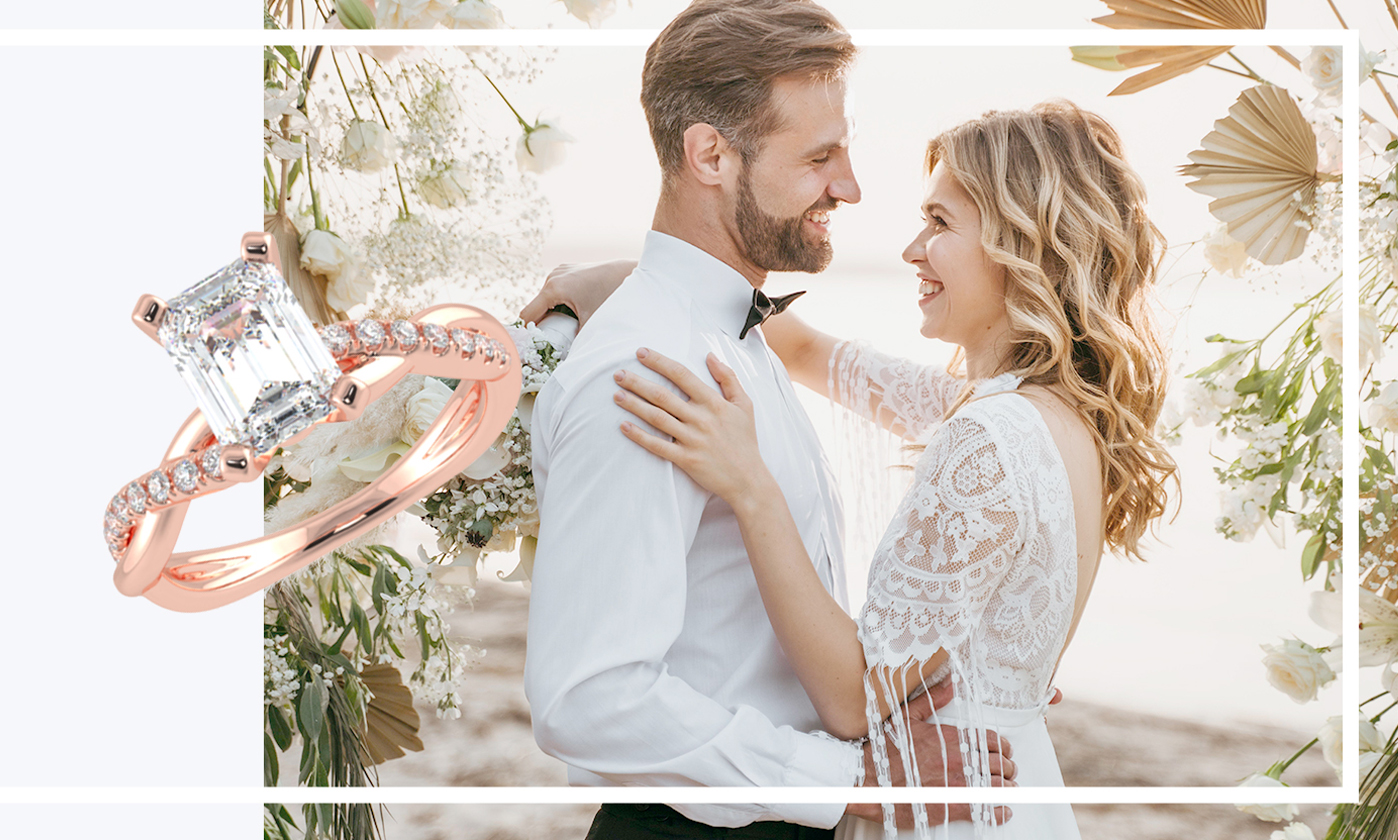

Three-Stone Engagement Rings
Three stone engagement rings consist of a center diamond surrounded by two diamonds on the side, which draws attention to the size and excellence of the center diamond or stone. The center diamond is usually mounted higher to complement the stone in the side and add a little depth to the ring. You can play around with different diamonds and curate a piece as per your liking. Princess cut or round cuts are very popular choices for the center diamond. The center-stone is usually a prong-set, bezel-set, or basket set. These settings accentuate the features of the center stone and make it more prominent.
Tension Set Engagement Rings
As the name suggests, Tension rings are held in place by the force and tension that the ring exerts on the diamond. Diamonds in tension engagement rings are held in place by the physical force of the setting, without the need for prongs. Diamonds appear to float in the air when set in a tension ring. Engagement rings with tension cuts are considered the safest engagement rings available today since the entire ring works to keep the diamond in place even more tightly than prong settings. The shape and cut of the diamond are essential for tension-cut engagement rings since they showcase the entire diamond. The most popular diamond cuts in tension set rings are round, princess, and emerald.

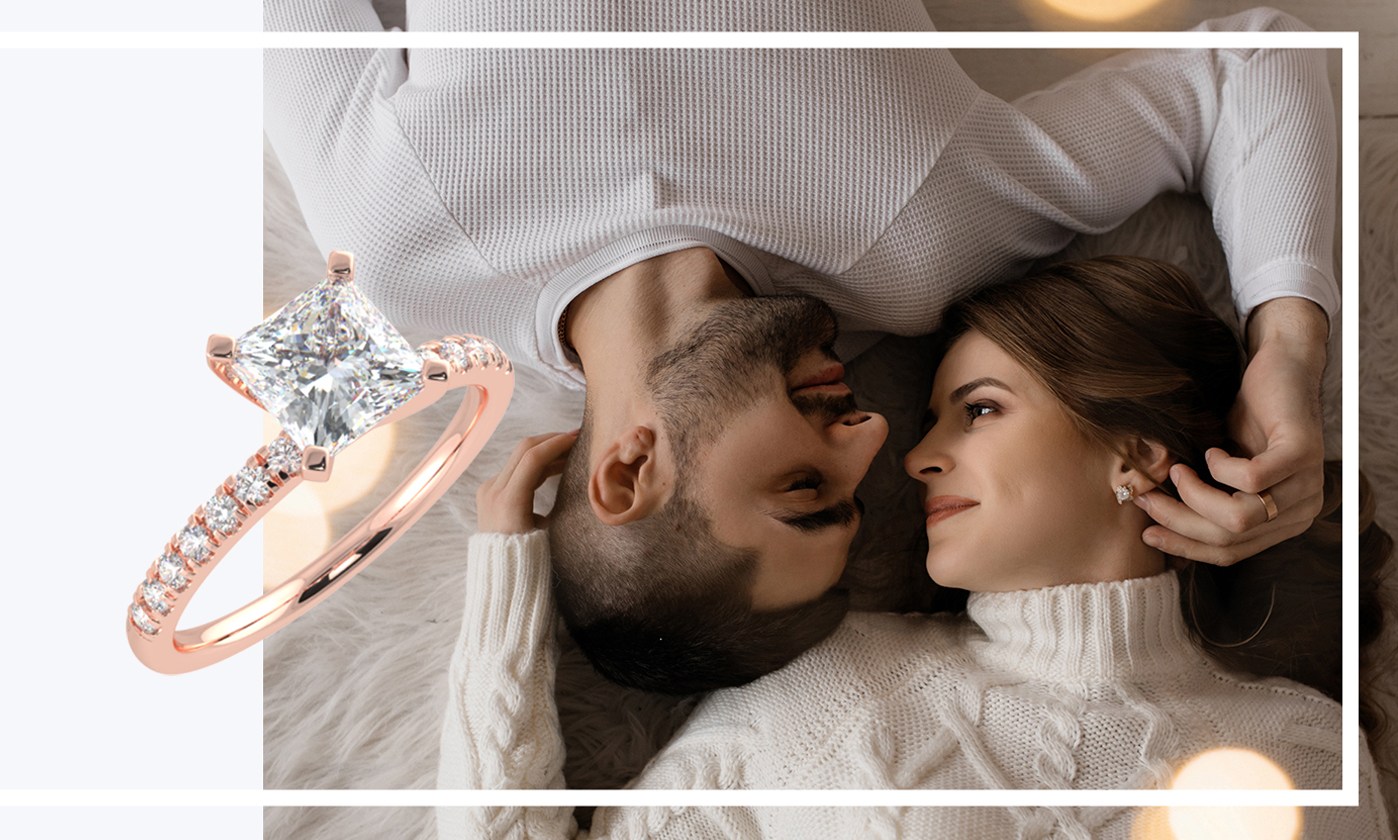
Pavé Engagement Rings
A pavé engagement ring has a series of very small diamonds encrusted all over the metal band; it gives an idea of a solid diamond surface. The pave setting can be either full pave or half pave. Full pave when pave settings go all around the band, and half pave when it stops halfway. There are tiny stones encrusted with a round or princess cut center stone. The small stones around the band create a brilliant fire.
Halo Engagement Rings
Halo engagement rings come in various shapes and sizes of the center stone. Halo engagement ring settings have a huge center stone with smaller pave diamonds around the band. The smaller pave diamonds make the center stone look more prominent in size and add to the sparkle. Halo engagement rings can also have gemstones like sapphires, rubies, and other colored gemstones.
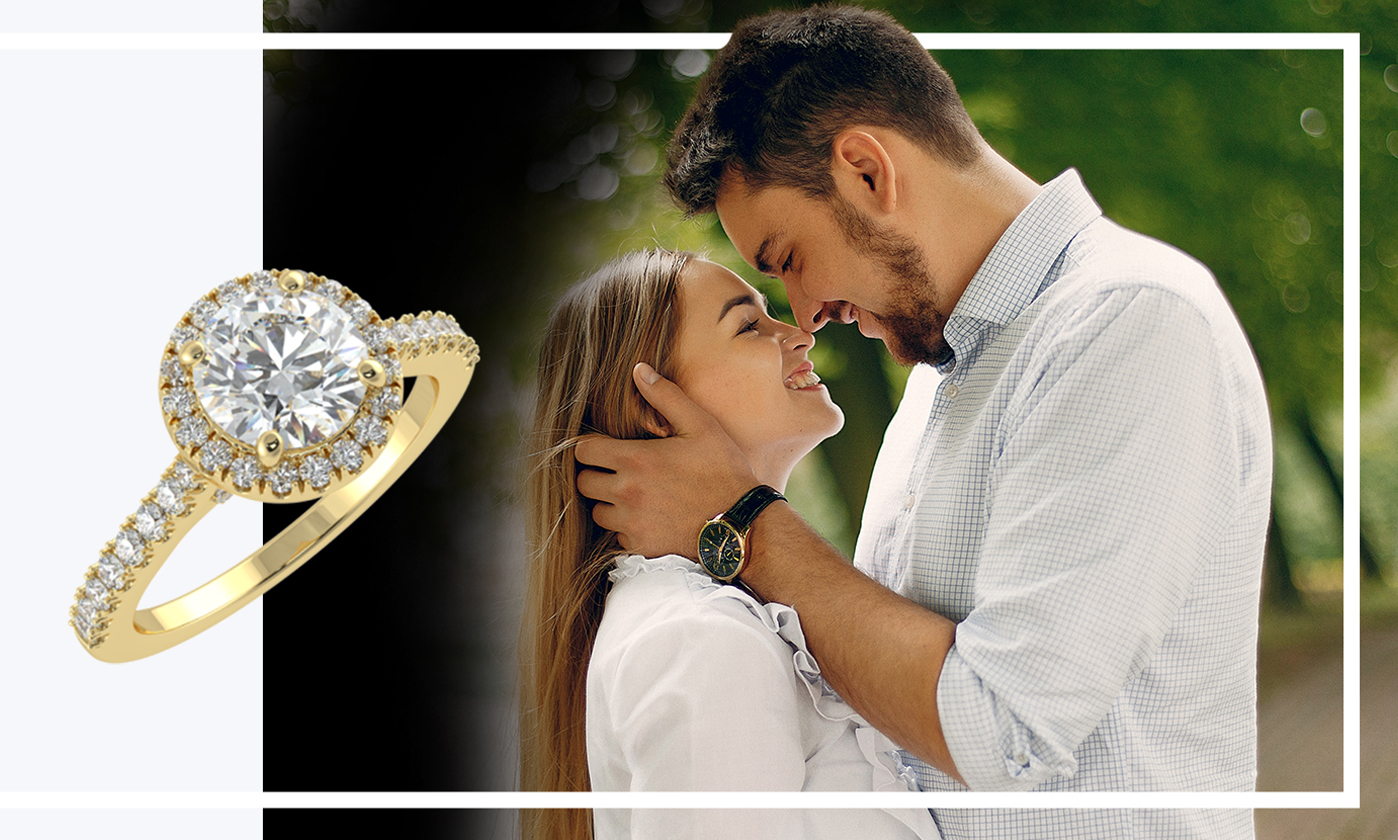

Vintage Engagement Rings
A vintage engagement ring offers the exquisite craftsmanship of vintage rings in a durable and lasting design. Vintage engagement rings use modern diamond cuts to maximize fire, brilliance, and light reflection. These designs are influenced by various periods in history. Gold, platinum, and white gold are available in vintage, and antique-style engagement rings by Studdedbay. Center stones are usually prong-set, bezel-set, basket-set, or basket-set in vintage rings.
Why are metals important?
The choice of metal for an engagement ring is an essential part of the design process. Choosing between white gold, yellow gold, or platinum is a matter of personal preference.The pros and cons of the different engagement ring metals should be weighed carefully before making your final decision.
White Gold Engagement Rings
White gold engagement rings are stunning, and they are becoming one of the most popular options for engagement rings. Both 14K and 18K white gold rings are available at Studdedbay. While white gold looks similar to platinum, it is significantly cheaper. It contains 58.5% gold in 14K gold, 75% gold, and 25% other metals in 18K white gold.
The white color of white gold is likely the result of alloying nickel, zinc, silver, and palladium with it, and often by plating it with rhodium, which is a shiny, white metal that is part of the platinum family. Setting this metal in white gold also protects it from color fading. White gold doesn’t usually tarnish but can develop a yellowish color which can be removed by re-plating.
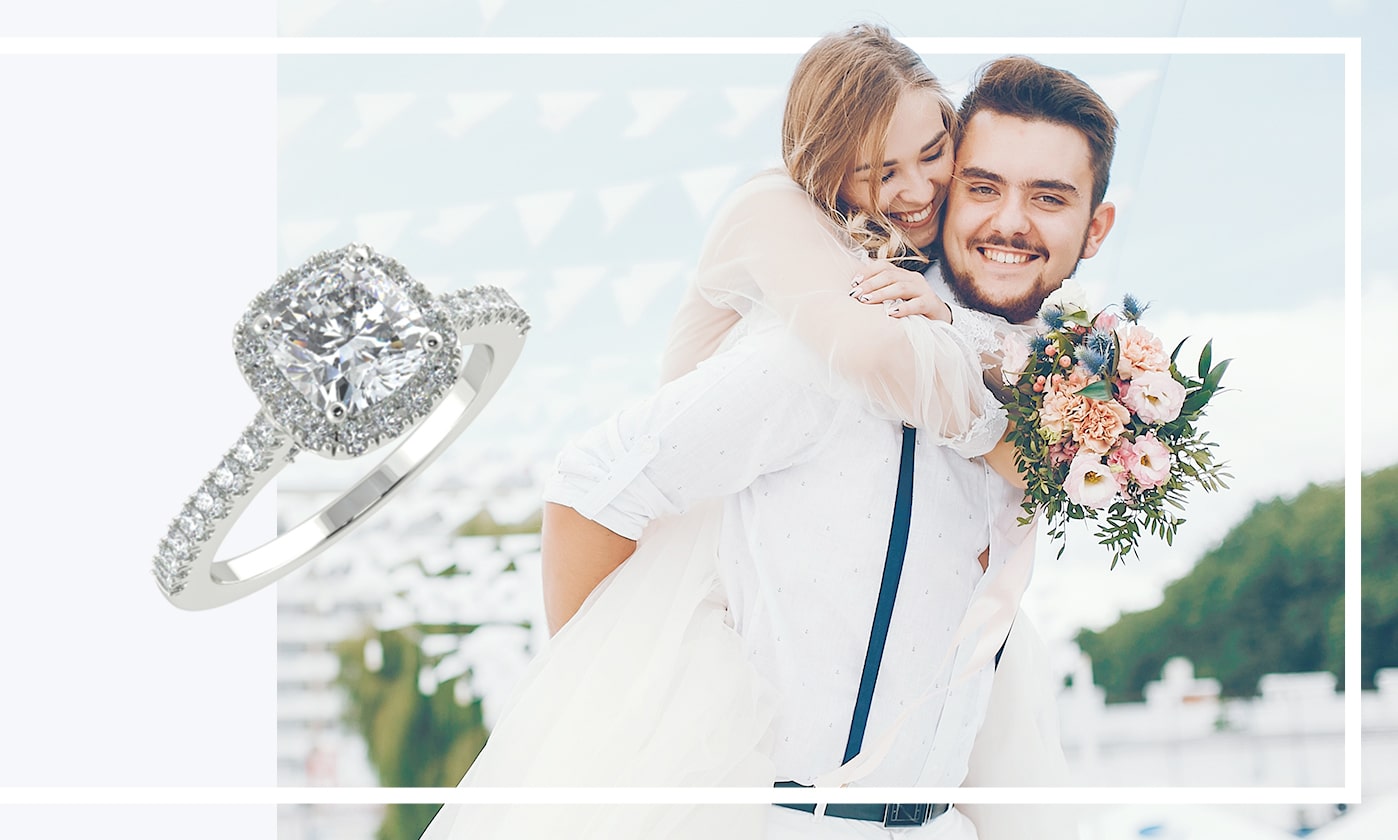
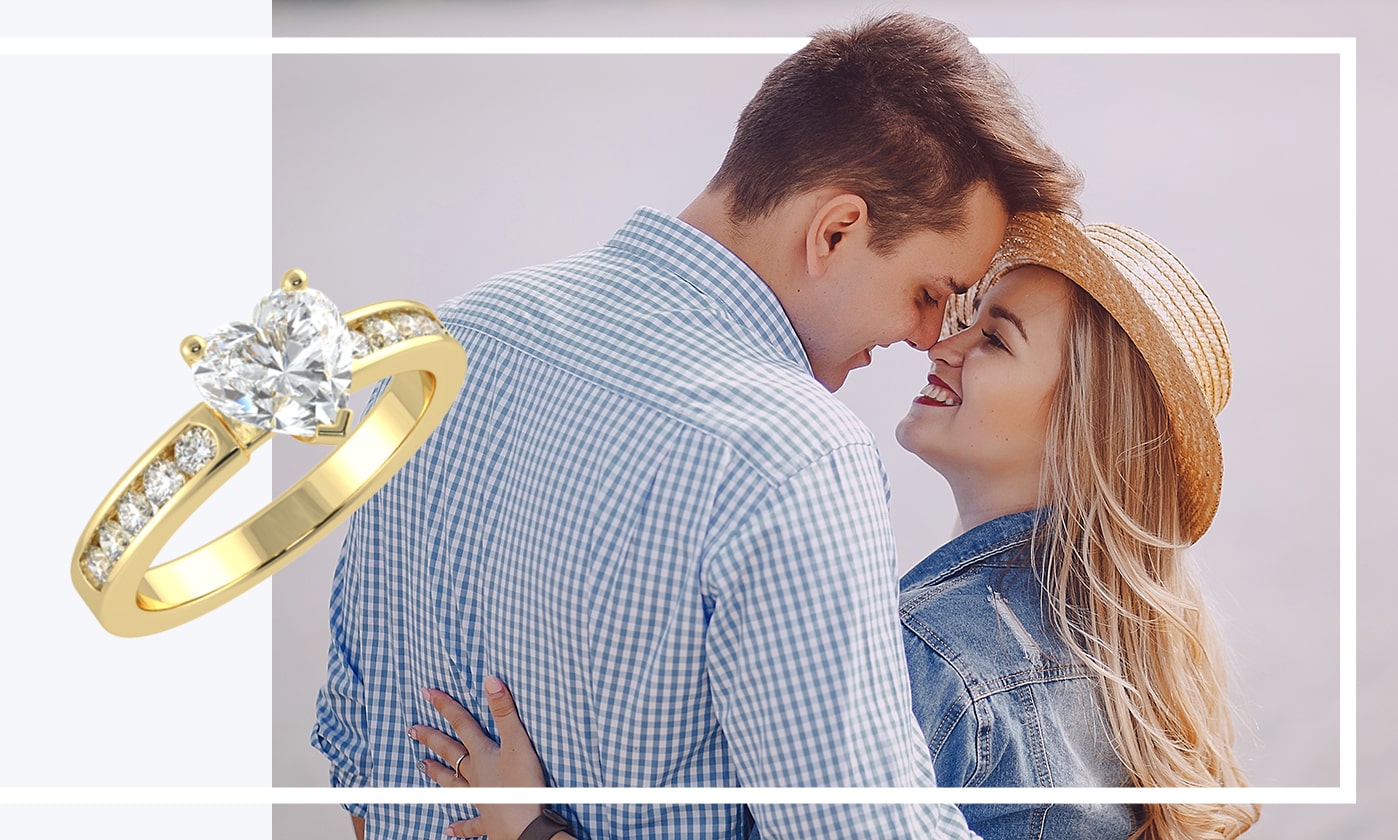
Yellow Gold Engagement Rings
Yellow gold is generally alloyed with copper and silver in fine jewelry, and the color depends on the quantity of pure gold in the alloy. Gold has the distinction of not corroding, tarnishing, or rusting, so it can be relied on to last long. Gold is also known to be more flexible than other precious metals.
24-carat gold is too soft to be used in jewelry; in general, the higher the karat level, the softer the gold. Fine jewelry is made using 18kt gold, which is 75% gold alloyed with 25% other metals. 14kt gold, which is 58.3% gold, is widely used in jewelry wherein durability and strength are crucial.
Platinum Engagement Rings
In recent years, platinum has become increasingly popular due to its durability and beauty. Platinum's even color and sheen make it a popular choice for settings in engagement rings, as these qualities amplify the sparkle and brilliance of diamonds. Furthermore, platinum's purity range of 90-95% makes it an ideal choice for those with metal allergies or contact allergies since it rarely causes allergic reactions.
Platinum is a strong metal and can handle a lot of stress, even more than other metals.It is also a naturally white metal that retains its brilliant white radiance over time, whereas white gold, which is combined with alloys to give it its white appearance, loses its white shade and starts to yellow over time; white gold jewelry must be re-plated to maintain its white color, whereas platinum jewelry retains its color naturally.

The majority of fine platinum jewelry comprises 95% platinum and 5% alloys. Most fine platinum jewelry uses 95% platinum, with 5% alloys. Iridium, palladium, and ruthenium are alloys that provide added strength to platinum. The closely-related iridium, palladium, and ruthenium are alloys that lend additional strength to platinum.

Rose Gold Engagement Rings
Rose gold is adored for its warm red color; it is an alloy of gold and copper. Due to its popularity during the early 19th century in Russia, rose gold was also known as Russian gold. It is also known as pink gold and red gold. The difference between a pink rose and red gold is the amount of copper.
The more copper there is in gold, the brighter the red hue becomes. Pure gold is a bright yellow, whereas pure copper is reddish. Rose gold is a hue that falls in between the two, depending on the composition of the metal. Rose gold is typically 75 percent gold and 25 percent copper.
Metal Care Guide
Keeping your jewelry safe is very important. Although white gold is durable, you should store it properly to avoid damage. Store it in a soft cloth bag or a fabric-lined jewelry box to prevent scratches. It would help if you made it a point to clean your white gold jewelry with the help of mild soap and warm water with a soft-bristle brush. Keep your jewelry away from corrosive chemicals like ammonia, bleach, etc. Lastly, never use paper towels for drying the jewelry. Always use a soft cloth. Follow these tips and keep your jewelry as shiny as new.
How To Choose The Perfect Engagement Ring?
Choose a Shape.
Narrow down what shape you want. Is it round, oval, marquise, or pear? Think about your style, something that you'd like? Every shape has a different price per carat. Ask your partner about their favorite shape and metal. Choose your shape and then consider size, carat, and color. Your partner should also be involved in this decision because they will feel like they are getting something they like! Or, do it with someone else—a close friend or family member who has your partner's best interest in mind.
Choose the Right Metal for the Band
Gold is gorgeous and durable, so it's an excellent choice for wedding bands. The band has a significant impact on how your ring will look. Choose a metal for the band that complements your ring and is something that you would want to wear every day. You can go with white gold, yellow gold, rose gold, or platinum.
Carat Size is Important!
When buying an engagement ring, it's vital to have a carat size in mind. Traditionally, one-carat diamonds are considered the most beautiful and appropriate for engagement rings, but it depends on your budget. Some people need to spend more on a ring because they want something unique, special, and memorable. Whether you choose one-carat or two-carats depends on personal taste and your budget.
Get Measured Accurately
Being measured adequately assures that your engagement ring will fit well and look beautiful on you. You can also ask your friends and family members for help as they have been there themselves and know what works best for them. It is not difficult at all. You have to measure your finger with the gauge tool that comes with the ring and see if it fits into the gap of your chosen ring size. A perfect fit makes it look elegant and unique at the same time. The last thing you want is for it to arrive and feel too big or too small.
Order Free Ring Sizer
You can order a free ring sizer before ordering a ring at Studdedbay. If you are confused about your ring size, we will send you a free ring sizer to find your accurate ring size.
Look for Certifications!
If you're looking for an engagement ring, always buy certified diamonds. They represent quality, which is the most crucial factor while purchasing an engagement ring or any precious jewelry. GIA, IGI, AGS certification ensures that you are getting the natural diamond.
Be Smart with Quality Cuts and Clarity.
The quality of the cut and clarity can make or break your engagement ring purchase. Ensure the amount is perfect and the clarity is flawless. Also, you need to be aware of how diamonds are graded before you buy one.
How carat affects price?
As one might anticipate, a diamond's price rises proportionately to its carat weight. The price can rise more sharply as you choose the greater carat size. This is true because larger diamonds are more expensive because they are more difficult to find than smaller ones.
You will not see any visible size difference between .95 carat to 1 carat but the price surely rises as the diamond size goes more than 1 carat,so considering size is very important factor in choosing solitaire according to your budget after choosing the carat size we have to check the other C's of diamond that is Color,Cut and clarity.
Depending on ones budget 1 carat and 2 carat in round shape is most sought out diamonds in industry.
Find Your Ring Size
Measure your ring size using String, Ruler, and Paper
If you want to get someone a ring, the best way to go about it is to ask the person itself. If it is supposed to be a surprise, seek help from family and friends. The average ring size for women is from size 3 to size 9, and the average ring size for men is size 6 to size 13. Size 5 to 7 is the most commonly purchased size for women, and size 8 to 10 ½ for men. These are standard ring sizes that can help you with the purchase. If you don't find your size, contact our experts and place a particular order. You can also check your ring size at home using a string, paper, and ruler. Let us discuss it in detail.
Steps to Measure your Ring Size
Step 1) Wrap paper or length of floss around the base of your finger.
Step 2) Mark the point where the floss or string meets with the help of a pen.
Step 3) Stretch the length of the floss and measure it along a ruler; note down the reading in millimeters (mm). Measure the string or paper with a ruler (mm).
Step 4) Choose the closest measurement on the ring size chart. There's your ring size!
Ring Sizing Tips
1. The ring should be comfortable and snug enough not to fall off the finger. Try not to pull the string and floss too taut since they can stretch.
2. In a scenario where the knuckle is more significant than the finger's base, you need to measure the length of both and get something in between that range.
3. The size of the finger can change according to time and weather. Try to measure your ring size at the end of the day.
4. Make sure you measure at least 3-4 times for accuracy.
Wedding Rings
Welcome to Studdedbay Wedding Ring Guides. Wedding Rings are once-in-a-lifetime purchases, and this guide will help you make an informed decision and choose the perfect wedding ring.
Although used as synonyms, wedding rings and bands are not the same. Rings are mounted with diamonds and gemstones, whereas bands are plain and straightforward.
Type of Wedding Rings
Classic Wedding Rings
Classic wedding rings are an excellent choice for newly engaged couples. In contrast to intricate or carved wedding rings, traditional wedding rings are known for their comfort. The wedding ring is worn by men and women all the time, so it should be comfortable to wear. They're sold in widths ranging from 2mm-8mm. Selecting the proper width is very important. It depends on your taste, some people like narrow bands and some wide bands. Women's engagement rings and their wedding rings often match somehow, but they can be of very different widths and still look gorgeous together.
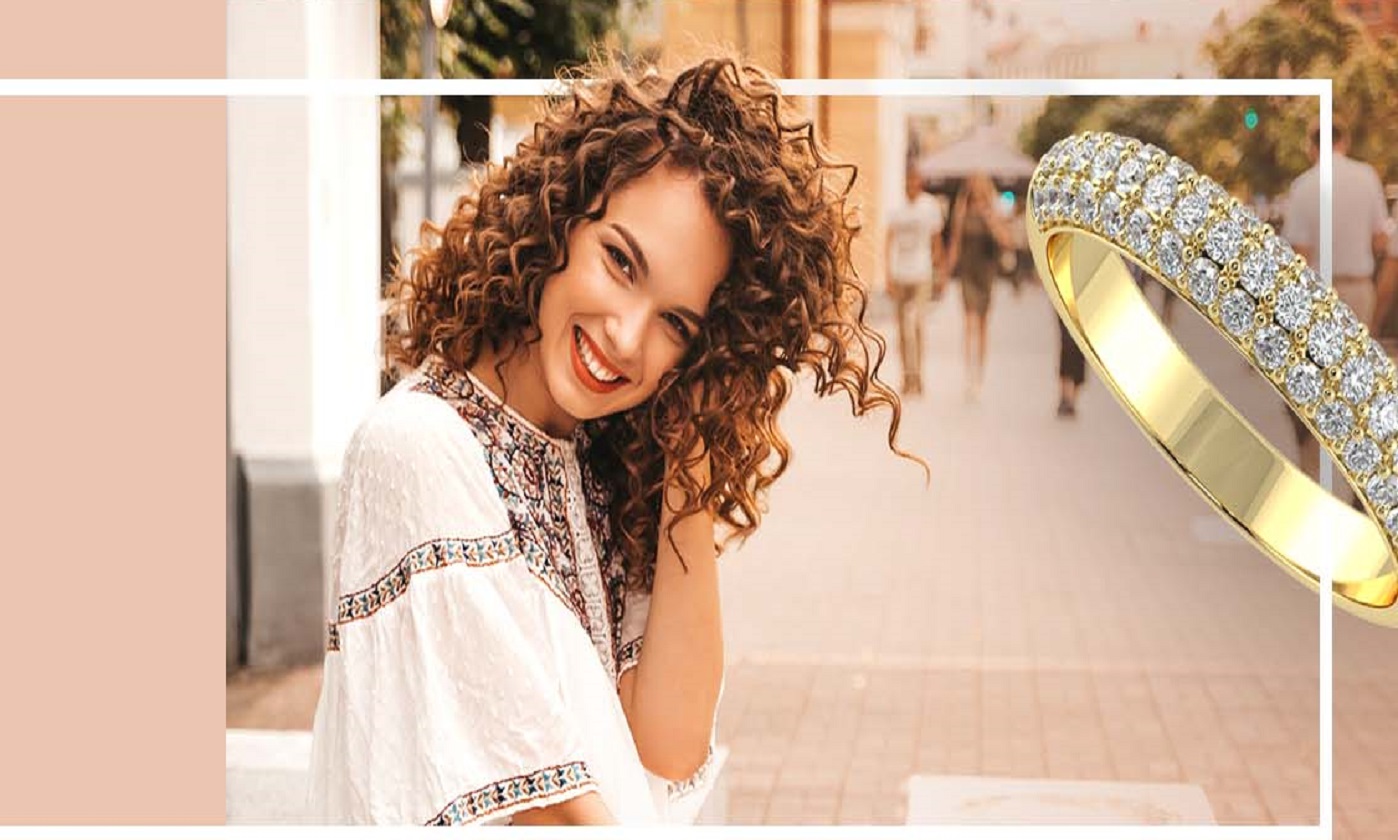

Eternity Wedding Rings
Eternity rings are a symbol of eternal and perpetual love. It shows commitment and loyalty towards your partner. An eternity ring is usually encrusted with diamonds and glistens when worn with your engagement or wedding ring. They make a perfect gift for anniversaries, valentines, and other special occasions.
Studdedbay has an exquisite collection of eternity rings available in various price ranges, metal types, and widths. We have channel-set diamond eternity rings, common prong eternity rings and shared prong eternity rings. Studdedbay has gorgeous eternity rings only for you. We'll help you find a call that speaks to you and pronounces your style.
Diamond Wedding Rings
Diamond wedding rings are a symbol of lifelong love and commitment. Diamond wedding rings can complement a classic or even carved wedding band beautifully. Studdedbay has the perfect wedding ring for any special occasion, whether it's yellow gold, white gold, or platinum diamond ring.
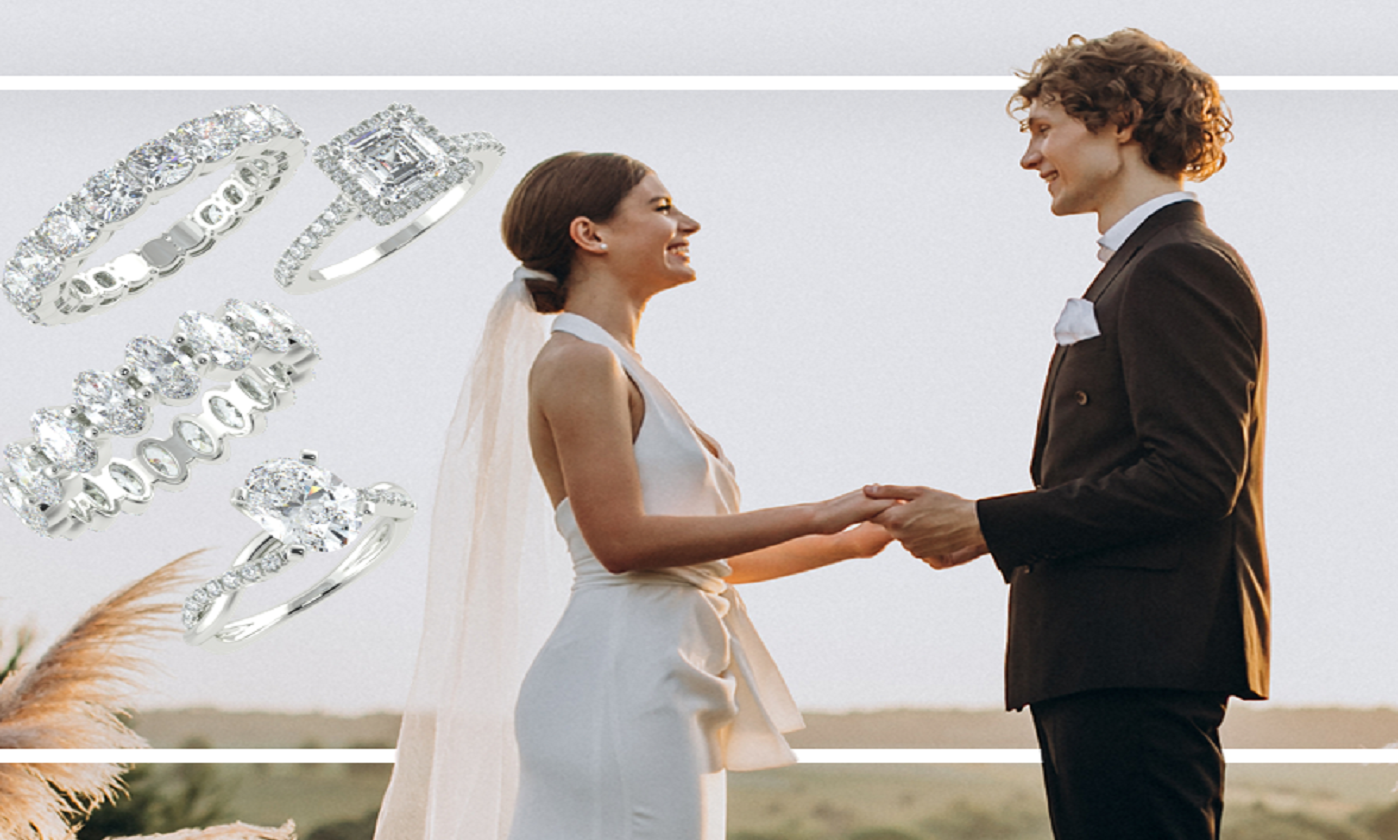

Anniversary Wedding Rings
Anniversary rings are the perfect gift for your anniversaries. It would be a great addition to your jewelry collection. Depending on your type, you can get gold or platinum anniversary rings. It comes in a range of widths, metals, styles.Most women try to match their anniversary rings to their engagement and wedding rings. This way, they can wear all three rounds at the same time. Every anniversary ring is of exceptional quality and craftsmanship. Women can choose from a stunning collection of anniversary rings at Studdedbay.
Carved Wedding Rings
Carved wedding rings give a twist to your everyday classic wedding rings. It looks refreshing and is a statement in itself. It would also look gorgeous next to your engagement ring. They have some carvings and intricate detailing going on instead of classic wedding rings. It is excellent for women who have plain engagement rings. Studdedbay has a beautiful collection of Carved wedding rings that would go perfectly with your personality.

Types of Wedding Bands

Classic Wedding Band
Classic wedding bands are a timeless choice when it comes to wedding rings. They are a simple metal band of platinum, yellow gold, white gold, rose gold, or platinum with a round finish. If you and your partner want to wear your wedding rings every day, then classic wedding rings are a good choice for you because they are highly comfortable. The width of the traditional wedding rings can be customized according to your taste, varying from 2mm - 10mm.
Flat Wedding Band
Flat wedding bands are flat on top like a pipe. They look modern and chic. At times they’re also known as pipe rings.


Half-Round Wedding Band
The half-round wedding ring has a round top. It is traditional yet timeless.
Carved Wedding Band
Carved wedding band is a band with carved detailing. They’re intricate and shiny, available in platinum, white gold, and yellow gold.

How to choose the perfect wedding ring?
"Wedding Rings" are symbolic of commitment, togetherness, and union. While the ring-type may vary from one couple to another, some classes are frequently used in every marriage ceremony. Wedding rings are the most precious and expensive possessions a couple can own. It is not just about money, but about symbolizing the love between two people—a few ways to choose your wedding ring the right way.
Integrate Your Style
Your wedding ring should be yours; it should speak your style. Think about the preferences in shape, cut, and metal while selecting a wedding ring for yourself. Whether you like classic pieces or modern ones, keep in mind that these jewelry pieces will be a part of you, therefore select carefully. See the jewelry you already own to get an idea of what you love.
Set a Budget
It is always a great idea to set a budget and stick to it. A budget gives you a rough idea of your spending capacity. The budget gives you clarity, and you don't go above your spending capacity and get disappointed. Let your jeweler know your budget, and they'll take care of the rest.
Shop Early
Many things go into planning a wedding; we advise choosing a wedding ring at least 3-6 months in advance. So that there is enough time for the call to be made and do alternations if any, it takes a lot of time to find the perfect wedding ring, so it is always a great idea to have some extra time in your hand.
Shop Together
It's always a good idea for the couple to shop together. It is easier to narrow down options when you shop together and find 'the one.' Both partners should try to be involved and choose something they adore.
Your Lifestyle
Before you buy a wedding ring, think about your lifestyle. Do you spend most of your time at a desk or doing physical activity? Choose a metal that isn't easily scratched if you're more into physical work like tungsten. Go for gold or platinum if you don't indulge in a lot of active physical work. Studdedbay has a vast collection of exquisite wedding rings and bands for men and women.
Men’s Wedding Ring
Men have had less choices in rings or jewelry in general, but we at Studdedbay are trying to change this. Wedding rings are a symbol of love and commitment, so naturally you need to be well-informed before selecting a one for yourself or your partner. We have wedding rings in various sizes and metals. You can choose from metals like yellow gold, platinum, white gold and more.
Metal Wedding Bands
Yellow gold
You can never go wrong with yellow gold. It is a classic piece to celebrate your love story. These gold bands are truly timeless, but if you’re looking for a modern touch, you can select a textured ring or a two-tone ring that pairs titanium with gold.
White gold
It represents a love that is perpetual and undying. White gold bands can be simple or intricate, depending on your style. They can be styled the way you like, polished rings, or diamond-encrusted pieces engraved.
Rose gold
Rose gold is becoming a popular alternative among couples. It looks modern and elegant at the same time. The pinkish hue adds a royal touch to it. Rose gold goes well with platinum and yellow gold.
Platinum gold
Platinum is a versatile and durable metal with an unmatched white finish. It makes gorgeous bands and offers the firmest setting for inlay diamonds.
Gemstone Guide
Gemstones make for the most exotic piece of jewelry: red rubies, green emeralds, blue sapphires, and more for your special occasions. High-quality gemstones with great precision and craftsmanship are available at Studdedbay.
Different types of gemstones
Sapphire
The brilliance of blue sapphire and the beauty of its hue are incomparable. Blue sapphire is always a highlight in any jewelry collection, whether worn alone or as part of an ensemble. The color is saturated and intense, making it one of the most popular gems for wedding rings, earrings, and other fine jewelry.
Emerald
Emerald is one of the most beautiful gemstones on Earth. It is a variety of beryl, a mineral found in various colors, including green and yellow. The finest emeralds have a deep shade that ranges from light champagne to a rich navy blue. Emeralds are hard and scratch-resistant, meaning they can be worn as rings or earrings. They also have a luster that ranges from a dull glassy sheen to a highly polished surface.
Ruby
Rubies are the most popular gemstone, and their color ranges from red to blue, but the most sought-after variety is the pink or red ruby. This color is caused by trace amounts of other elements, such as chromium and manganese, which give the stone its hue. The color is captivating, and the clarity is stunning.
Amethyst
The amethyst gemstone features a range of beautiful colors, from purple to pink to red. Amethyst is a popular gemstone and is often worn as an engagement ring or necklace. They are also some of the most expensive gems in the market. Amethyst is known for its spiritual and calming qualities. It is often used in jewelry to reduce stress.
Blue topaz
Blue topaz is a transparent blue-colored gemstone. It is available in various shades of blue, from sky blue to intense ink color. It symbolizes wisdom and knowledge. It can be used in making necklaces, earrings, rings, and more.
Citrine:
Citrine is a gemstone in the shades of yellow, orange, or red. These gemstones are often considered powerful crystals because they represent successful mental clarity and help you think creatively—a number of features that can help you achieve success in your life. Additionally, citrine stones are suitable for promoting optimism and energy levels.
Opal
Opal is a type of gemstone that is made from the mineral opal. It is known for its features, such as its luminescence and fluorescence. Opal is often found in blue, green, purple, yellow, brown, and black colors.
Aquamarine
Aquamarine is the Latin name for ‘seawater.’ The preferred color is a moderately dark solid blue to slightly greenish-blue. The facets of aquamarine are often exceptionally transparent with a glass-like luster, making it look stunning.
Garnet
Garnet gemstones are available in different shades of reds, greens, and other colors in between. Its clarity depends on the type of garnet you choose; red garnets don’t possess eye-visible inclusions.
Peridot
The Egyptians called peridot the “gem of the sun.” It is available in shades of green, the most preferred color being pure grass green. It is eye-clean, but black dots are visible upon magnification. It is cut in various shapes like oval, emerald, cushion, and more.
Tourmaline:
Tourmaline has a wide range of color intensity and tone. Inclusions are more visible in pink to reddish tourmaline than green to bluish tones. It is available in different shapes and sizes.
Pearl
Pearls are the most-loved gems of all time. They occur in a variety of colors naturally. The blemishes on the surface of the pearl say a lot about its quality. Spherical pearls are the most valuable and sought after.
How to buy a Gemstone Ring?
Buying a gemstone ring is just like purchasing any other ring. It is an investment, and we understand the same. Cratsmiths has an exquisite collection of beautiful gemstone rings, but first, let us know how to buy a perfect gemstone ring for yourself or your partner.
Set Budget
Plan ahead of time how much you want to spend on a gemstone ring. Having a budget always helps. You don't get distracted. Be transparent about your budget with the jeweler you're visiting. Spend the amount you feel comfortable with, and make sure you discuss the same with your partner as well. Your budget also depends on the type of gemstone, carat weight, and metal type.
How to buy a gemstone?
Pick your gemstone
The center stone is the actual show. All the eyes are drawn first to the center stone and determine the price. Studdedbay has an exquisite collection of gemstones like amethyst, ruby, emerald, sapphire, and more.
Pick a shape
Round, cushion, princess, oval, pear are some common shapes. The most popular ones are round and emerald.
Your style comes first
A good way of understanding your preferences is to look at your collection. The type of gemstone you love, metal type, setting, etc. It gives you a fair idea of what you're looking . Also, let your jeweler know your choice, and they'll suggest the best pieces for you.
Choose a metal of your choice.
Choosing a metal is crucial, whether you want the versatility of white gold or the vintage feels of yellow gold, or simply exquisite platinum. Choose a metal according to your lifestyle and allergies, if any.
Choose an ideal timing.
Now that you have a precise idea of "your kind" of a ring set the proposal's date ahead of time. Plan everything, have a safe time to deliver the call, and make last-minute changes, if any. Take at least three months to map a plan and start working.

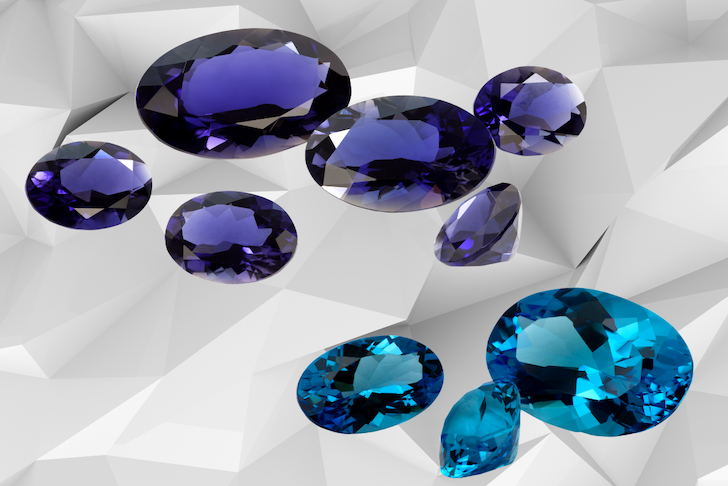
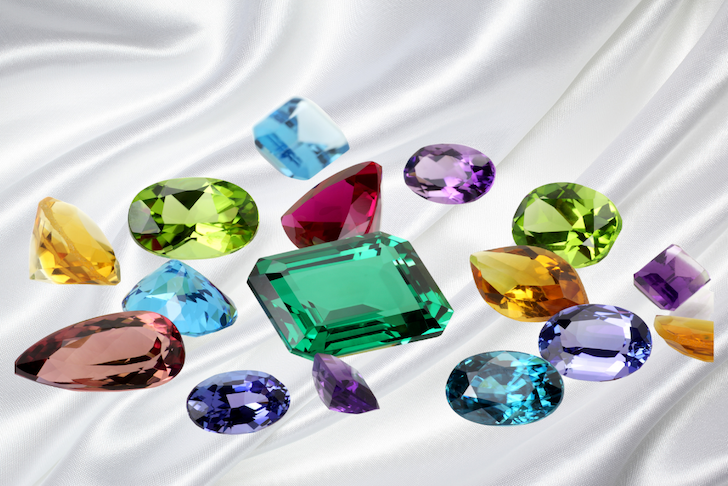
The Ultimate Diamond Care, Maintenance & Repair Guide

You’re reading this probably because you feel your ones are not as shiny as they used to be. We all want our diamonds to be just as sparkly and shiny as they were when we got them. No diamond can always be shiny and new without proper care and cleaning sessions. Continue reading for some great tips to keep your diamonds safe and shiny.
Diamonds take a long time to form and are very hard but not indestructible. Therefore, they can last for generations, so they are passed down to coming generations as heirlooms. It has an emotion attached to it that makes it timeless. You can expect longevity, but they wouldn’t always be as perfect as new.
Diamond jewelry losing its luster over the due course of time is a common phenomenon. You can have the best cut, color, carat weight, but there can still be many factors that can negatively affect your diamonds.
How to Store Your Diamond Jewelry the Right Way?
The way you hold your diamond jewelry is just as important as keeping them lustrous and shiny. Your engagement ring, anniversary gifts, or any other piece of a diamond should all be stored properly to avoid damage. Longevity increases when you store them mindfully.
Storing like with like is highly recommended. Having different boxes for different kinds makes it much more organized and easy to find. Diamond is naturally hard, and it needs to be kept in a separate container, soft cloth pouch, or the same jewelry box you got with it. If you place it in the same box with other metals gemstones, they might get damaged. Make sure to keep the jewelry box in a cool, dry, and safe location.
How to Keep Your Diamond Shiny and Sparkling?
First, let’s understand what you should avoid while handling a diamond. It is always good to wear protective clothing while applying sunscreen, wearing perfume, and using hairspray. These have harsh chemicals and abrasive solutions which can dull the diamond.
Second, make sure you always pick the band and not the stone. This keeps the diamond secure in the setting and prevents natural oils from your hand from getting accumulated in the rock.
Here are a few ways that we recommend to keep your diamond jewelry as perfect as new
If you want to clean your diamond jewelry at home, use a soft-bristle brush and hot soapy water. Clean gently, and that would do the job. Get your hands on a non-abrasive jewelry cleaner if you are looking for professional finesse. Just make sure the cleaner is safe for the diamond. After you are done with the cleaning bit, grab a clean cloth and wipe it thoroughly. You’ll see the shine you wanted.
Another way of cleaning is the ammonia solution. Take one part of ammonia to six pieces of water and mix them well. Rinse the diamond in the solution to renew the brightness. It cleans the diamond without causing damage.Use it only for diamond protection and not for gemstones or pearls.
What to Avoid While Taking Care of Your Diamonds?
Diamonds and other precious stones are considered one of the most durable materials globally. Clean your diamonds with lint-free cloths, commercial jewelry cleaning solutions, and household detergents. Do not use abrasive cleaners such as powdered cleansers, ultrasonic cleaners, or steam cleaners on these items. These methods can cause scratches and damage the surface of your precious stone.








